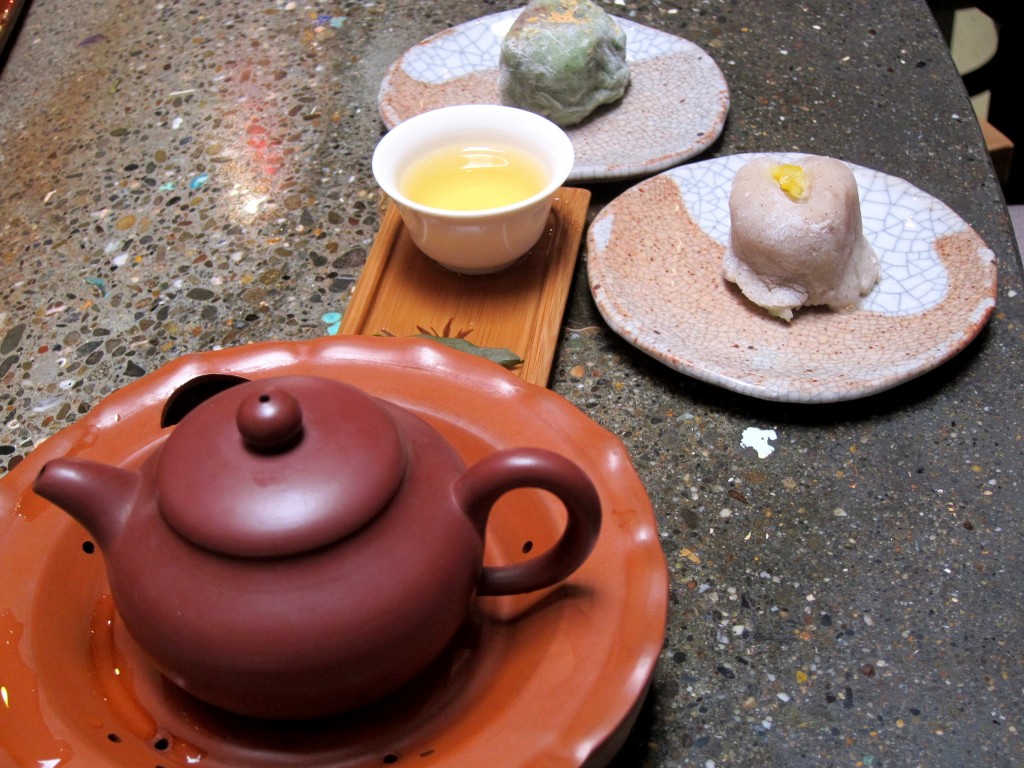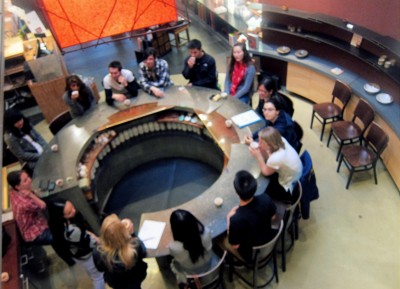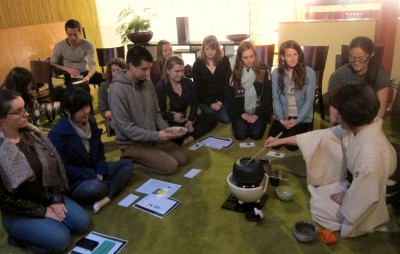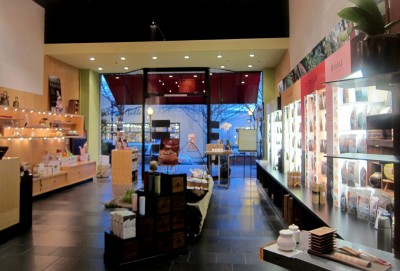
Once a week last spring, I took the 51B line to Teance at 5 p.m. so that I could make it to TeaCal by 5:30. TeaCal is a DeCal class on tea, and last spring was the first time it was organized at Teance. Actually, after the first few weeks, I started taking the 4:30 bus, sometimes even the 4 p.m. bus, because I wanted to arrive early to talk to the bartender and enjoy more tea before the class started. That’s right, Teance has a bar for tea and a staff member to make tea in front of you in gongfu style and talk a bit about the tea, its production, its steeping method, its health benefits and sometimes even its history.
The tea bar at Teance is unique in Berkeley because it’s round. Most tea houses don’t have bars, and most bars are long rectangles at which you can’t talk to anyone except the people next to you. I’ve lost count of how many amazing conversations I’ve had at this round bar. Its smooth, cool-yet-earthy shell-and-glass surface usually surprises the customers, who begin conversing in mutual admiration.
Complete strangers share one another’s bewilderment as they inhale the gardenia aroma of freshly infused Baochong oolong or share a cup of Yunnan Gold and nod in agreement when one person joyfully exclaims that she detects a peppery note in the tea’s sweetness. Then they go on to share business dreams, youthful memories, their children’s performance in school, political and religious beliefs. They bond over the tea bar. “The roundness brings people together,” says Winnie Yu, Teance’s director and founder.
Every year, Yu travels to the fog-shrouded tea mountains in Asia and hand-selects whole-leaf teas from award-winning tea farmers. She says one connection always leads to another while she searches for the best teas.
“Asians are all about connections — otherwise, they wouldn’t talk to you anyway,” Yu said. “You know one tea master. Then they introduce you to a farmer. A lot of farmers connect to other farmers, family members, their friends in the industry. Through years and years of legwork and introductions, eventually you find some good farmers.”
Yu’s motivation for opening Teance was simple: to create a public environment where tea drinkers could gather and share teas.
“Let’s say you want to drink tea with your friends — where would you go?” she asked. “You go to a cafe? A coffee shop? It’s horrible tea there, and it’s usually teabags. It’s also a different kind of environment. Coffee shops smell like coffee. They’re not very tranquil. They’re not aesthetically the kind of place that I would like and that I’m used to in Asia.”
So with her friend Fu-Tung Cheng of Cheng Design, Yu strived to make Teance the serene oasis that shoppers on Fourth Street could duck into to seek shelter from the hustle and bustle outside and at the same time still feel connected with the outdoors through the abundance of sunlight, the water cascade that showers from the ceiling into a small pond with goldfish in it, the fresh flowers and even the bamboo coasters.
It’s no surprise that Teance’s calming atmosphere attracts many artistic patrons: designers, musicians, poets, dancers. It also hosts a number of book-signing events, Lunar New Year festivals and spring harvest tea parties, at which teas are served with artisan snacks such as mochi, tea-flavored ice cream, tea-flavored truffles and cookies all handmade by Teance staff members and their friends, all of whom embody the “slow food” concept that defines Berkeley cuisine.
Yu’s wish is for people to “think about tea as fine dining, as produce, a world of excitement, something very sophisticated but also extremely accessible.” Currently, Teance carries roughly 65 types of tea across all categories: white, green, yellow, oolong, red, pu’er, herbal. These teas come from Japan, China, Taiwan, India and sometimes Korea, depending on the season, considering that, just like those of wine, the tastes of the teas change from season to season.
All this may seem daunting at first, but TeaCal is a good start for students like me. For everyone else, the bar and the knowledgeable bartenders make it easy to taste everything and find out what one likes. The more enthusiastic tea learners can also make a reservation for a private tea lesson with an experienced bartender, and the cost is just the regular bar cost.
“We try to carry the highest grade of each type of tea,” Yu says, “so that the tea bar is the place for (customers) to be adventurous and try different teas and train their palate (for the high-quality teas).”
The more I learn about this beverage, some of which comes from trees that are hundreds of years old, not to mention the yixing teapots and the porcelain gaiwans in which it’s infused, the more I realize how much there still is to learn. The range of taste alone is overwhelming.
There’s the simpler Anji Baicha with a buttery note or the somewhat complex Honey Jialong that tastes sweet like jicama with an aroma of chamomile and plumeria. Then there’s Song Zhong Phoenix, in a single sip of which you can taste pine nut, unburnt cigar, malt, clove, the black tip of a young banana and something sweet, aged, smoky, resinous that you can’t exactly pin down with a name. And you know that this tea is high in quality because you can steep it again and again, sometimes more than 10 times, and the flavor remains strong or new flavors emerge.
One evening, I asked Mr. Moghaddam, one of the managers of Teance and the bartender that evening, to tell me the name of the tea that I was enjoying. Refusing to say its name, he told me to enjoy its flavors and the moment because even for the same tea, it will never be the same again. That may sound too philosophical, but there’s a bittersweet fact behind it.
In 30 years, these kinds of artisan tea will be history because of pollution and climate change and, most importantly, because the tea masters are aging. The youngest tea master in China is about 60 years old, and it takes a few decades to master the art of growing, picking and producing the tea, which does not yield enough financial benefit to entice the young generations to take up the art.
“Now is the time to drink tea,” Yu said.
Disclaimer: This post is a re-publication of my feature of Teance on the Daily Californian.


